
Introduction
Intel’s next-generation CPUs for the desktop have finally been revealed, the SKUs, the specs, all the speeds and feeds, and of course information on the architecture, changes, etc. You won’t see Intel calling this its 15th Generation, but if you follow logical progression this would be a 15th Generation (Arrow Lake-S) which follows the last 14th Generation (Raptor Lake-R), which follows the 13th Generation (Raptor Lake-S), which followed the 12th Generation (Alder Lake-S).
There was a more major change between the 12th and 13th Generations, but no changes for the 14th Generation, as it was a direct refresh of the 13th Generation. Now, for this next generation, a lot of changes are taking place, so the new “15th Gen” (which we aren’t calling 15th Gen), is a major architecture change and also a socket change, Socket LGA1851, requiring a new motherboard socket, and a new chipset will be available this generation.
Let’s jump to the pricing first, and we’ll talk about the SKUs below. The Intel Core Ultra 9 285K will be $589, the Intel Core Ultra 7 265K will be $394, the Intel Core Ultra 7 265KF will be $379, the Intel Core Ultra 5 245K will be $309, and the Intel Core Ultra 5 245KF will be $294.
Intel Core Ultra 200S Series Processors (K-SKUs)
The CPUs will be available for sales and pre-orders on October 24th. The official name for this series is Intel Core Ultra 200S Series CPUs, the -S denoting Desktop variants, not to be confused with the mobile parts. There will be the familiar 9, 7, and 5, but that will be preceded by Intel Core Ultra now, and then new model numbers after—for example, Intel Core Ultra 9 285K, the highest-end SKU. You’ll see Intel Core Ultra 7 and Intel Core Ultra 5 CPUs. Let’s look at the full SKU chart below.
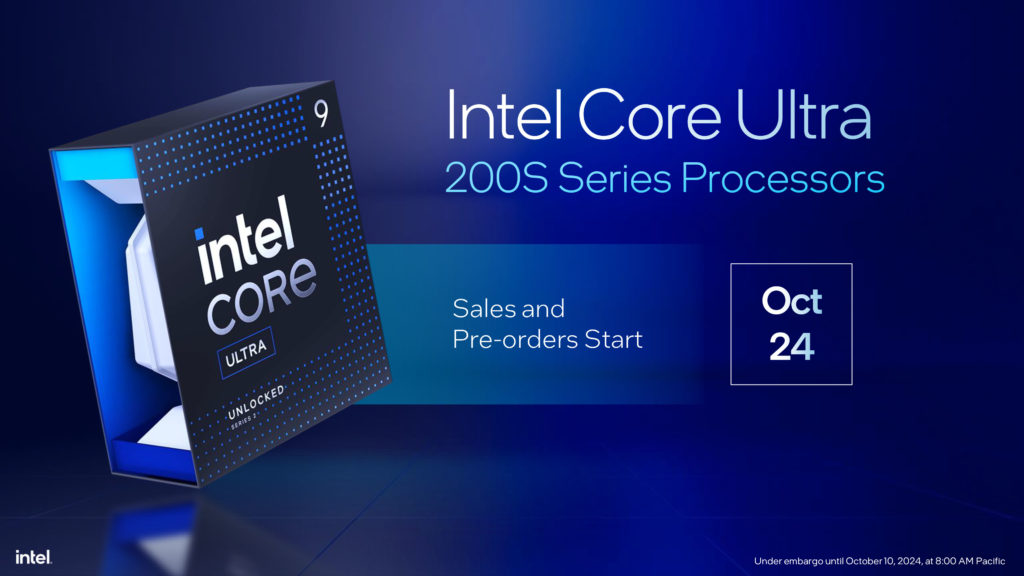
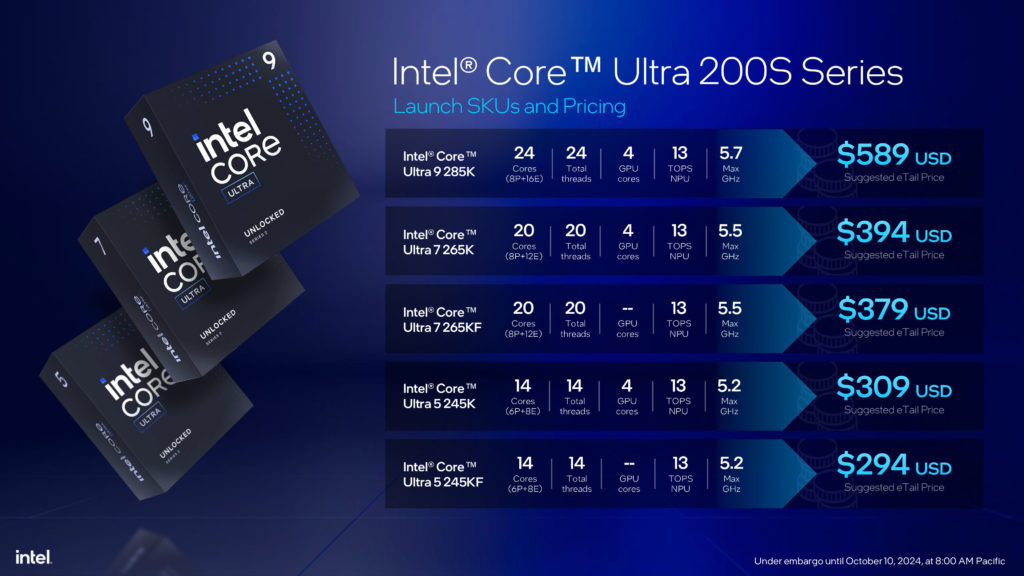
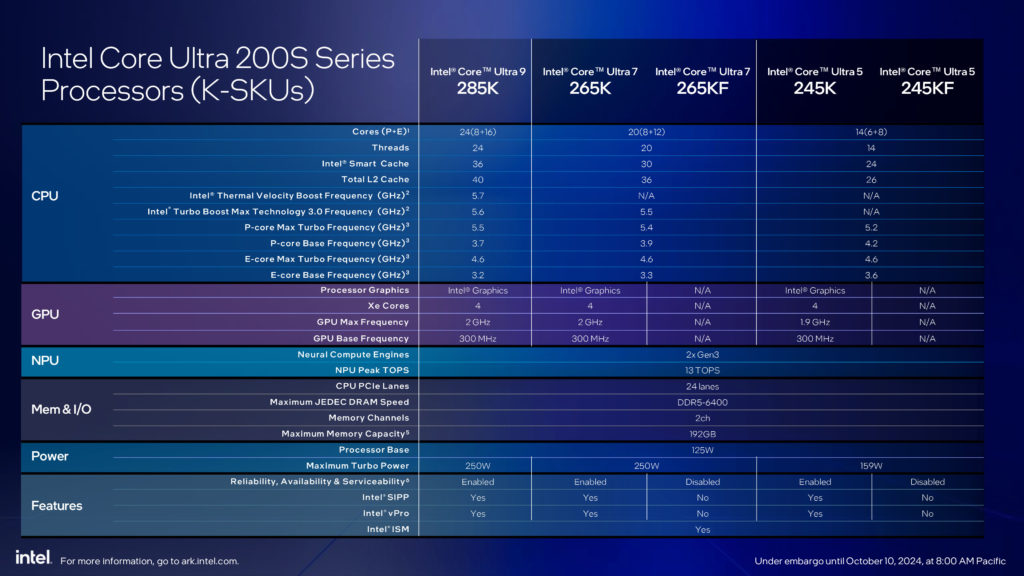
One of the most important things to know about the Intel Core Ultra 200S Series for desktops is that SMT (Hyperthreading) is no longer supported. This means there are only as many threads, as there are cores, combining both the P-Cores and the E-Cores. Yes, the hybrid nature of P-Cores and more efficient E-Cores, based on two different architectures, is still the name of the game with this generation, but Hyperthreading is no longer a thing, all in the name of saving power.
Starting at the top is the Intel Core Ultra 9 285K which will have a Suggested eTail Price of $589. This is an 8 P-Core/16 E-Core CPU which gives us 24 cores or 24 Threads. It has an L3 cache of 36MB and an L2 cache of 40MB. It supports all the frequency technologies from Intel, so it has Intel Thermal Velocity Boost, Intel Turbo Boost Max Technology 3.0, a P-Core max frequency, a P-Core base frequency, an E-Core max Turbo frequency, and an E-Core Base frequency (too many boots IMO, why not just one?). This means it has an Intel Thermal Velocity Boost of 5.7GHz, and an Intel Turbo Boost Max Technology 3.0 frequency of 5.6GHz. The P-Core Max frequency is 5.5GHz, and the Base frequency is 3.7GHz. The E-Core Max frequency is 4.6GHz and the Base frequency is 3.2GHz.
The Intel Core Ultra 9 285K also has integrated graphics based on the Xe technology, and there are 4 Xe Cores. The GPU max frequency is 2GHz and the GPU base frequency is 300MHz. The Intel Core Ultra 9 285K has an NPU on board, based on Meteor Lake’s NPU at a peak TOPS of 13. There are 24 CPU PCIe lanes, and maximum JEDEC DDR5 speeds of 6400MT/s in 1DPC. The processor base power is 125W, but the maximum Turbo Power is 250W. We confirmed that PL1/PL2 will be set at 250W by default.
Next down the stack is the Intel Core Ultra 7 265K CPU with a Suggested eTail Price of $394 and the 265KF with a price of $379, the F SKU simply lacks the integrated graphics, and a few features, but otherwise is the same. The Intel Core Ultra 7 265K is an 8 P-Core/12 E-Core CPU which means it has 20 cores and 20 Threads capability. Its L3 cache is reduced to 30MB, while its L2 cache is reduced to 36MB. The only frequency feature the Intel Core Ultra 7 265K does not support is Intel Thermal Velocity Boost Frequency, otherwise, it supports the same turbo features as the 285K.
The Intel Core Ultra 7 265K CPU will run at an Intel Turbo Boost Max Technology 3.0 Frequency of 5.5GHz, with a P-Core Max Turbo Frequency of 5.4GHz and P-Core Base Frequency of 3.9GHz. The E-Core Max Turbo Frequency is 4.6GHz and the E-Core Base Frequency is 3.3GHz. In the K model, it has the same Xe graphics with 4 cores at 2GHz just like the 285K. It also has the same NPU and performance, DDR5 support, and PCIe lanes. While its processor base power is 125W, the Maximum Turbo Power is still 250W, so PL1/PL2 at 250W.
Finally, rounding out the current stack is the Intel Core Ultra 5 245K with a Suggested eTail Price of $309 and the 245KF at $294, again the F SKU lacks integrated graphics and some intel features. The Intel Core Ultra 5 245K is a 6 P-Core/8 E-Core CPU which gives it 14 cores or 14 total Threads. This CPU has an L3 cache of 24MB and an L2 cache of 26MB. It lacks Intel Thermal Velocity Boost and Intel Turbo Boost Max Technology 3.0. Therefore, the P-Core Max Frequency is 5.2GHz, with the Base Frequency at 4.2GHz. The E-Core Max Frequency is 4.6GHz and the Base Frequency is 3.6GHz.
The Intel Core Ultra 5 245K uses the same Intel Xe graphics with 4 cores but reduces the GPU Max Frequency to 1.9GHz. It also has the same NPU with 13 TOPS, the same DDR5 support, and PCIe lanes. On this CPU the Processor Base power is also 150W, but the Maximum Turbo Power is 159W.
Intel Core Ultra 200S Series Improvements
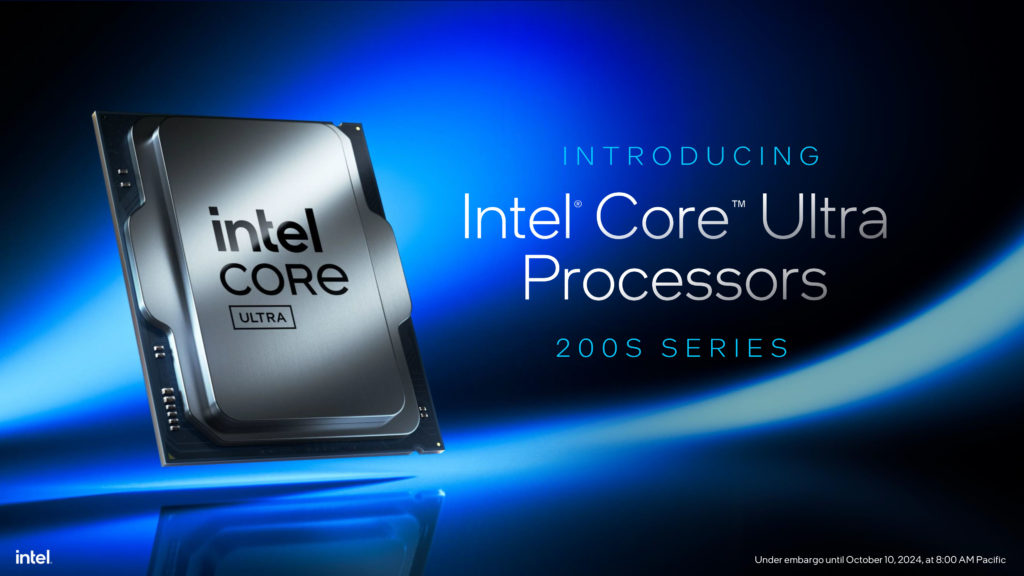
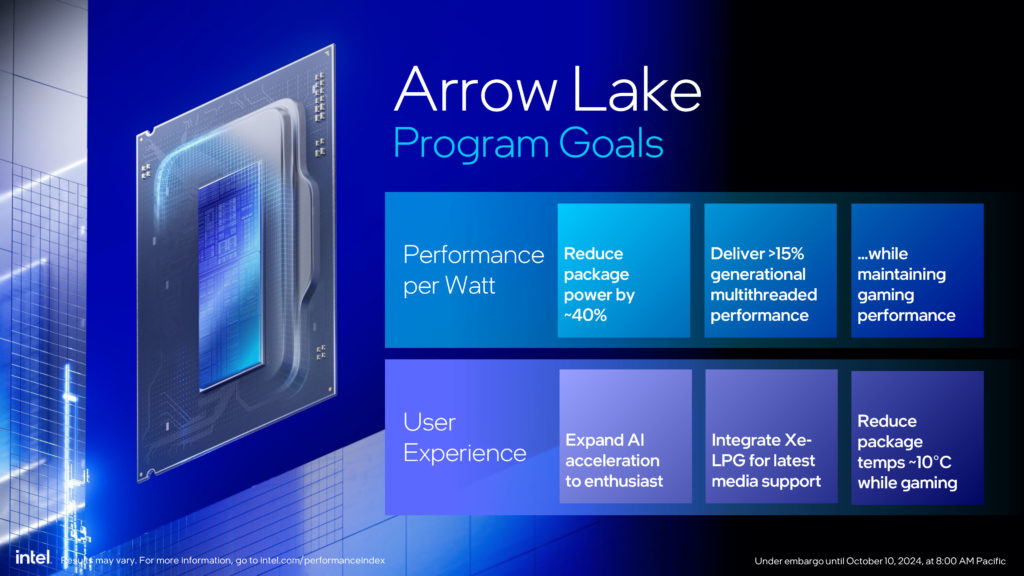
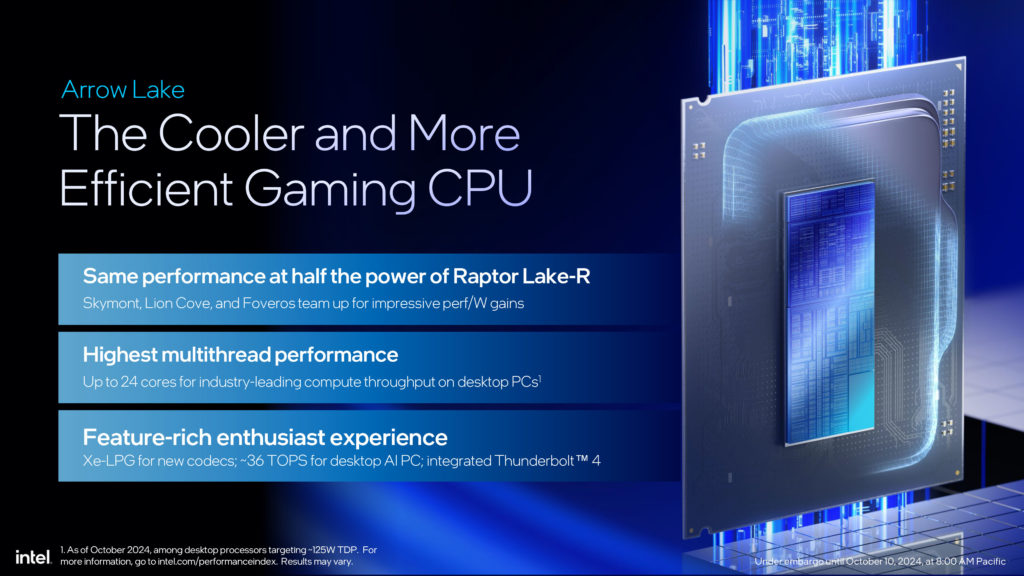
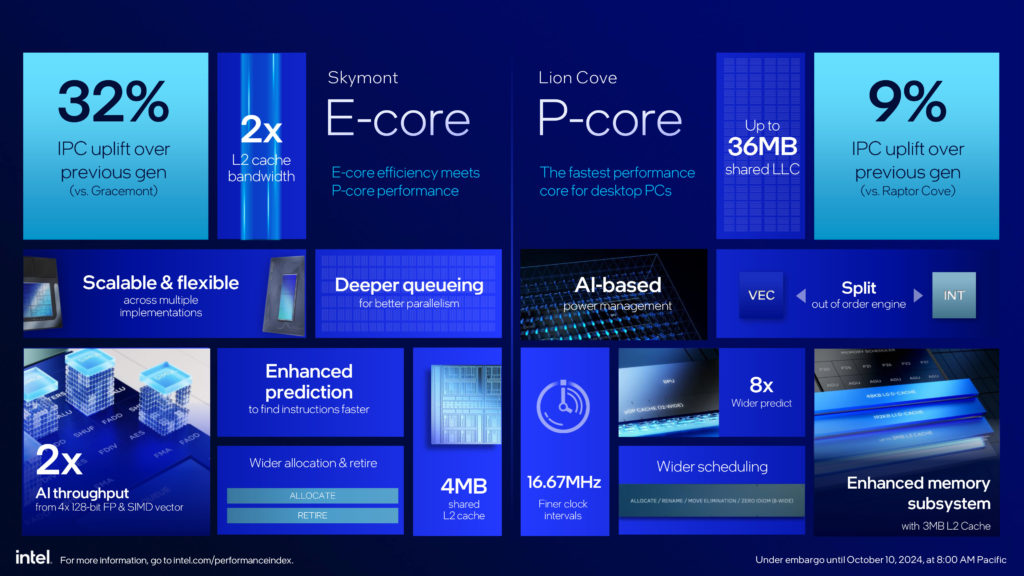

We are going to quickly walk through the presentation, you are welcome to read each slide in detail. The name of the game with the Intel Core Ultra 200S series is a performance-per-watt improvement, the goal was to reduce package power yet deliver performance. In the third slide, it is stated quite clearly that the Intel Core Ultra 200S series will deliver the same performance at half the power of Raptor Lake. This is how you need to think of Arrow Lake in Intel’s own words.
Performance has been improved in the new Skymont and Lion Cove cores, at a lower power, versus Raptor Lake. Intel is claiming a 32% IPC uplift with Skymont E-Cores over the previous generation of Gracemont E-Cores. Intel is claiming a 9% IPC uplift with Lion Cove P-Cores over the previous generation of Raptor Cove E-Cores. Various improvements include more cache bandwidth, and up to 36MB of shared cache, and a shared L2 cache that has increased. Other deeper enhancements, such as wider scheduling, wider allocation, enhanced prediction, and finer clock frequency adjustments.
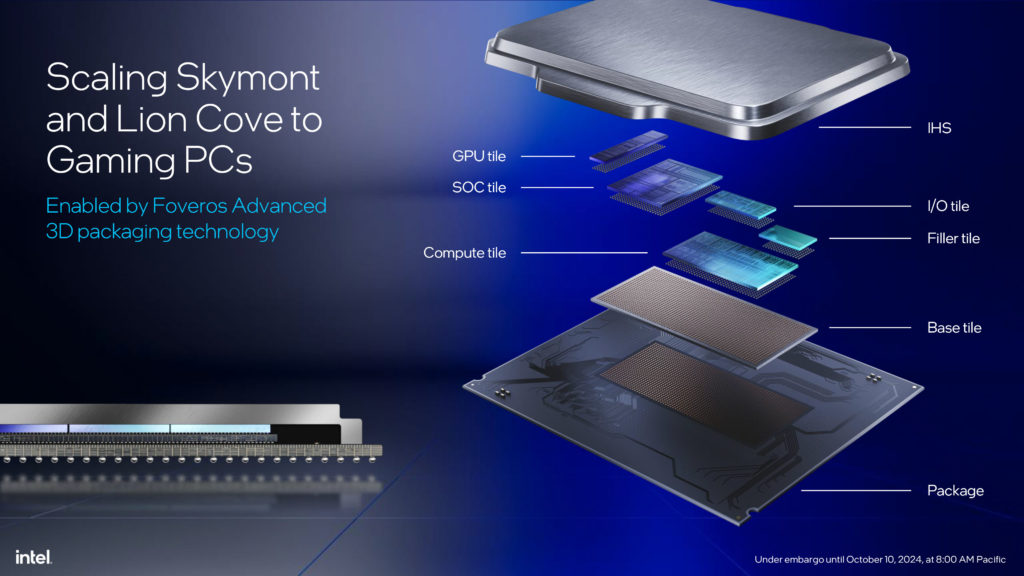
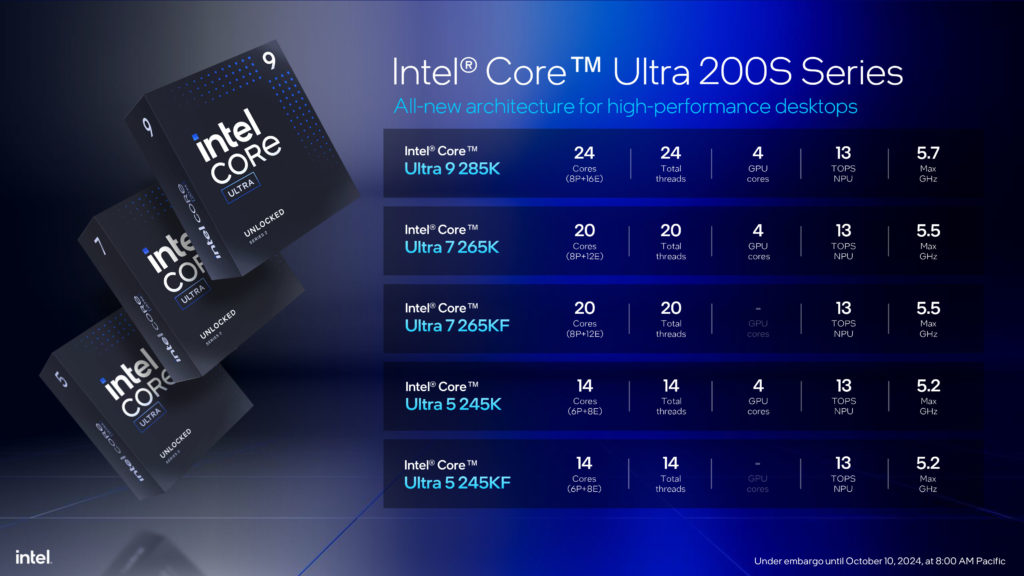
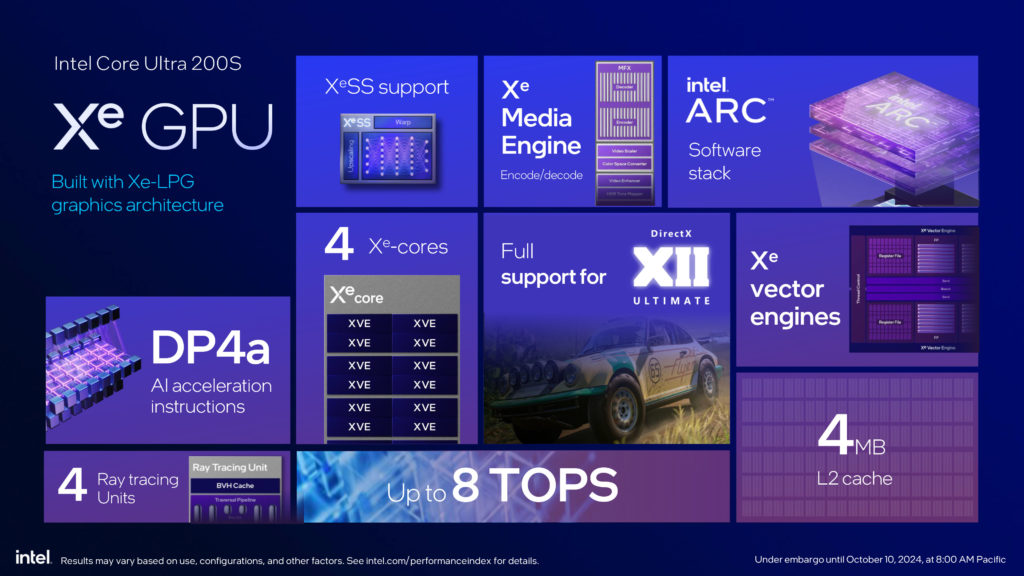
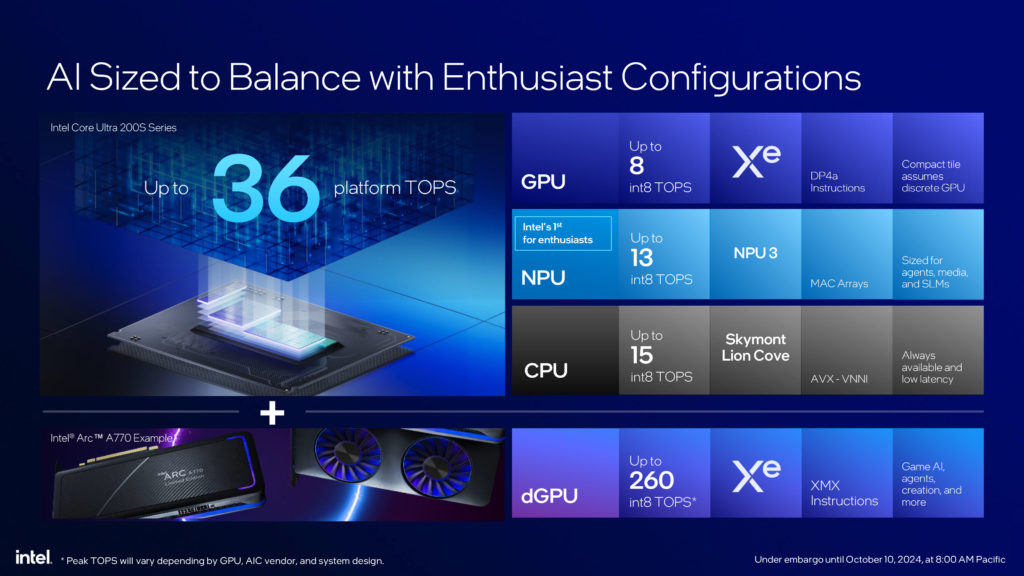
For the integrated graphics, they have been upgraded to Intel’s Xe-LPG graphics architecture. There are 4 Xe-Cores for each CPU, with 4 Ray Tracing Units, and the Intel ARC software stack. These cores support only DP4a, however, there is no XMX hardware engines in this. The Xe-Graphics can support up to 8 TOPS. The real benefit here is the inclusion of Intel’s Xe Media Engine for Encode/Decode for codec support and features like Intel QuickSync.
The Intel Core Ultra 200S Series is melded with the package, base tile, filler tile, I/O tile, Compute tile, SOC tile, GPU tile, and then the IHS on top in this now familiar design from Intel. All of this is based on Intel’s fabrication and packaging. The way Intel calculates this is to take the GPU (capable of 8 TOPS), combined with the NPU (capable of 13 TOPS), and the CPU (capable of 15 TOPS) to come up with the total TOPS of 36 for the Intel Core Ultra 200S series, but consider that is with everything combined and utilized to its max potential and efficiency.
Power Savings
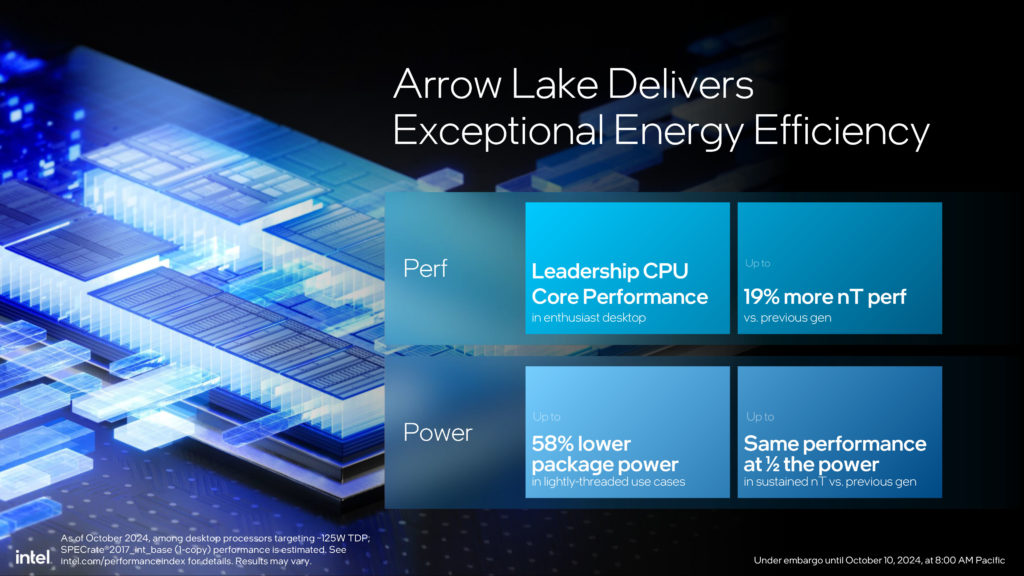
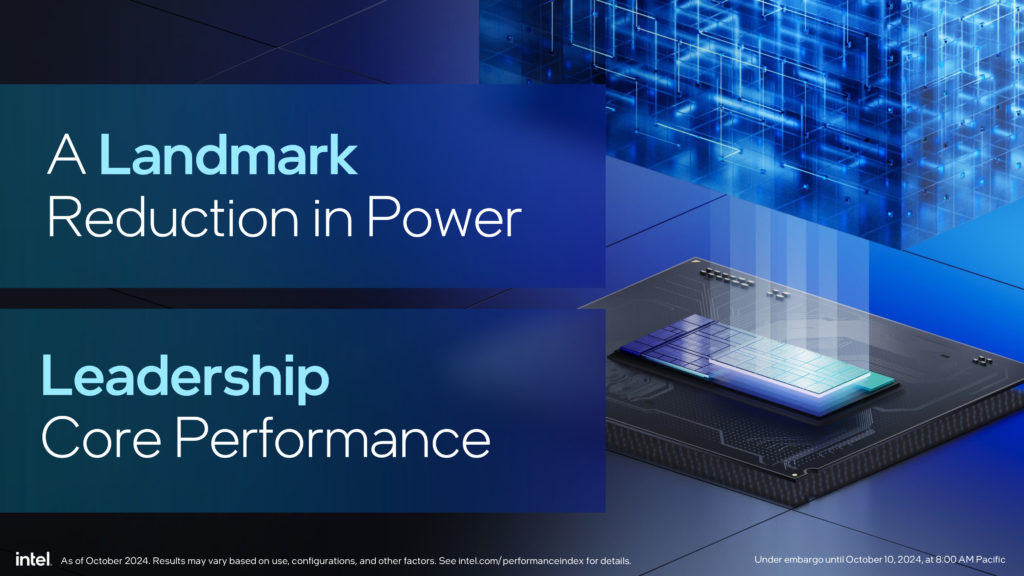

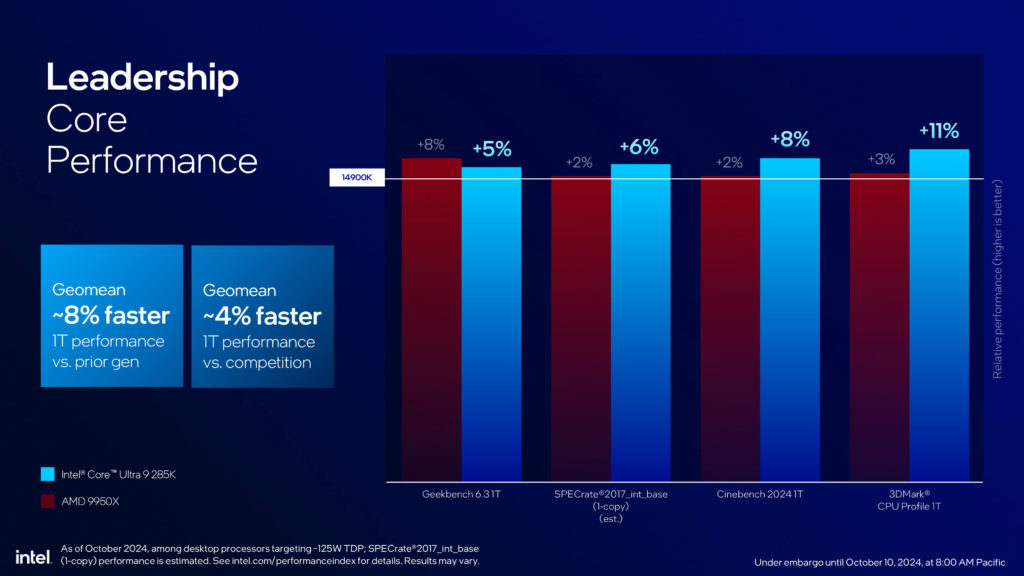
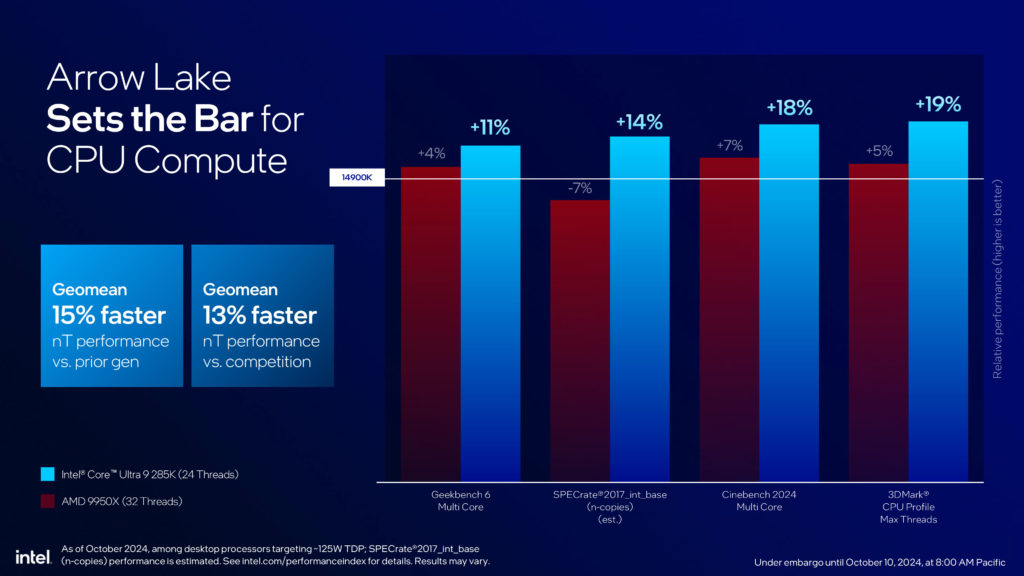
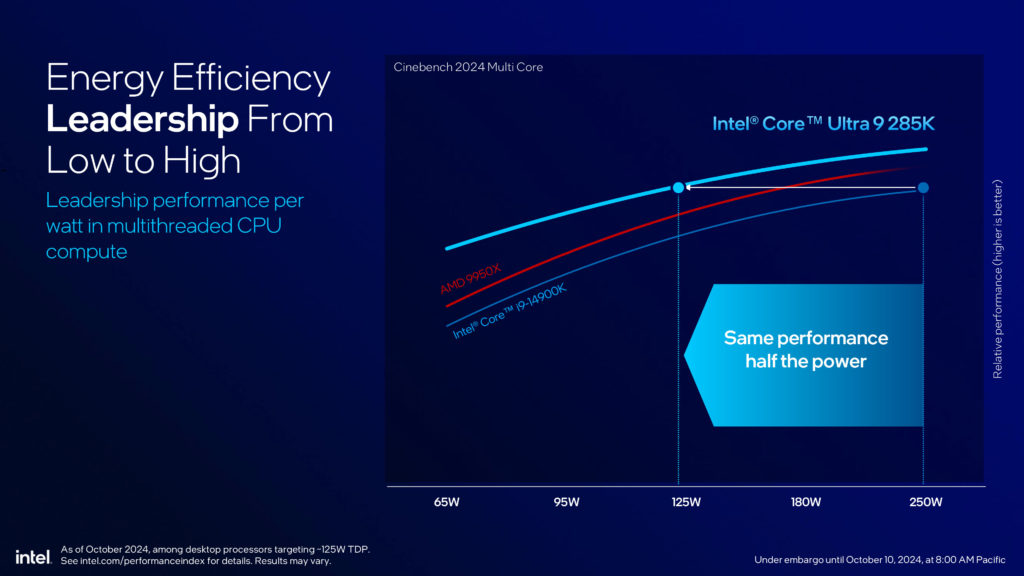
As we said at the top of this announcement, power savings is the name of the game. Intel claims Arrow Lake Halves productivity power consumption compared to Raptor Lake. In these synthetic benchmarks, we see a 42-44% reduction in power, compared to the 14900K. In one instance, up to a 58% power reduction. In a geomean, 8% faster 1T performance versus the prior gen, and 4% faster 1T performance versus the competition. In multithreading performance, Intel is claiming 15% faster versus the prior generation as a geomean and 13% faster versus the competition as a geomean. There’s a large range here, so it will depend. Intel claims that Arrow Lake at 125W delivers the same performance as Raptor Lake delivered at 250W.

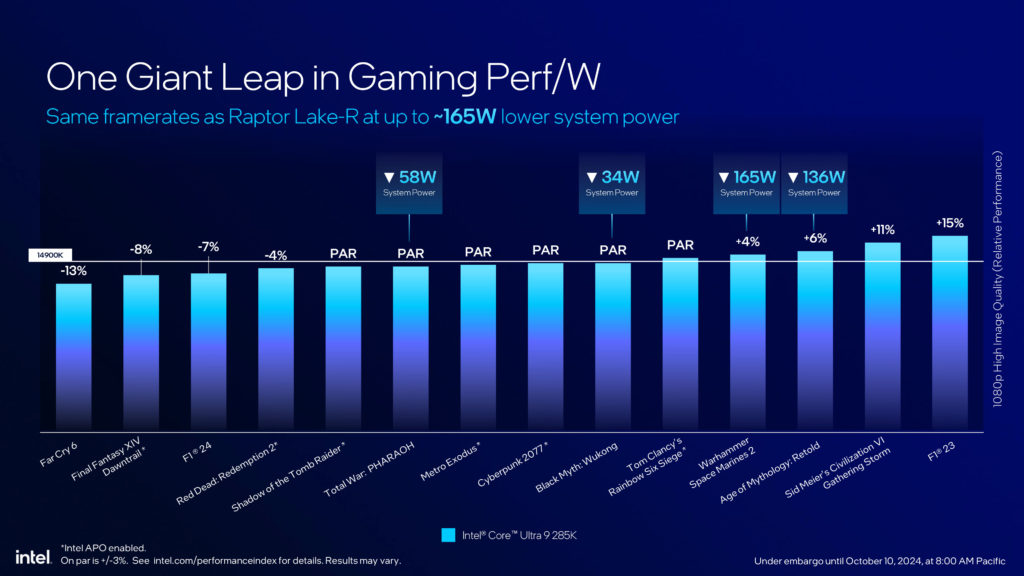



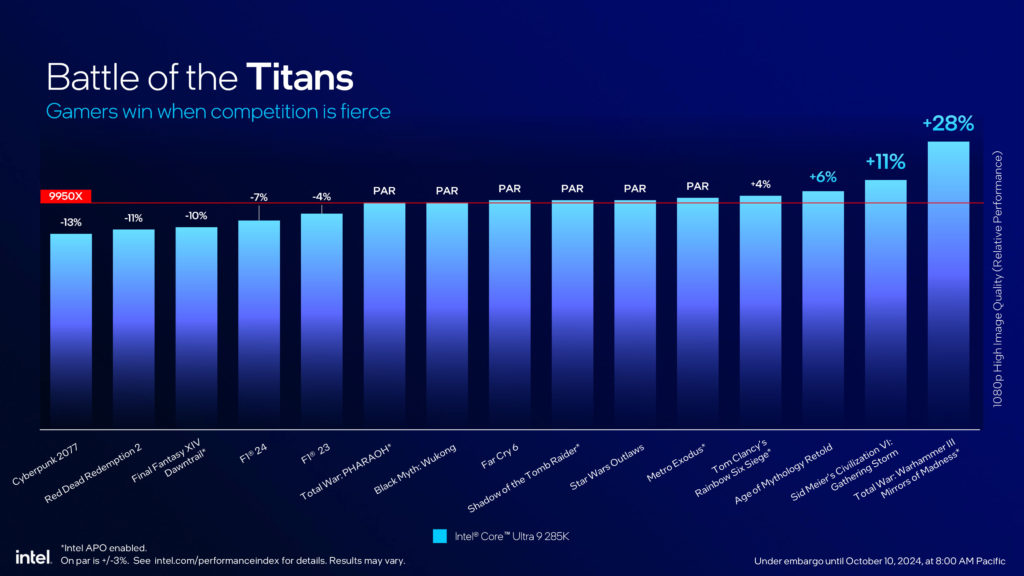
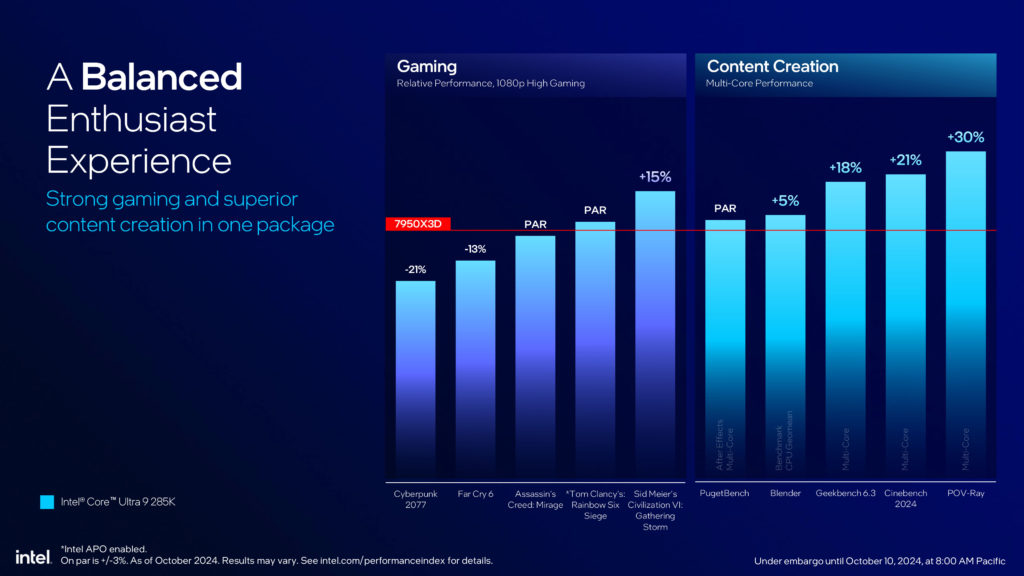

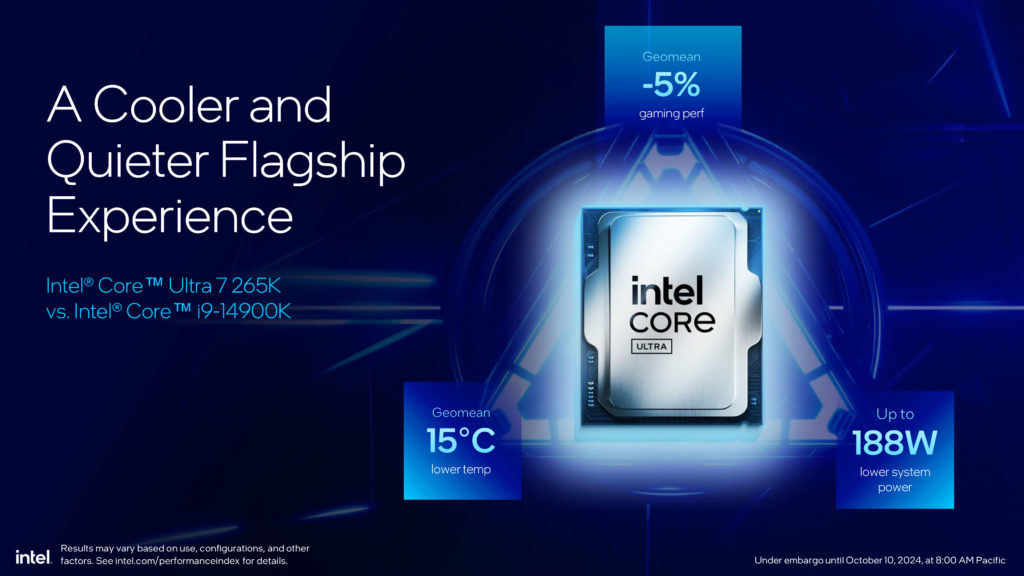
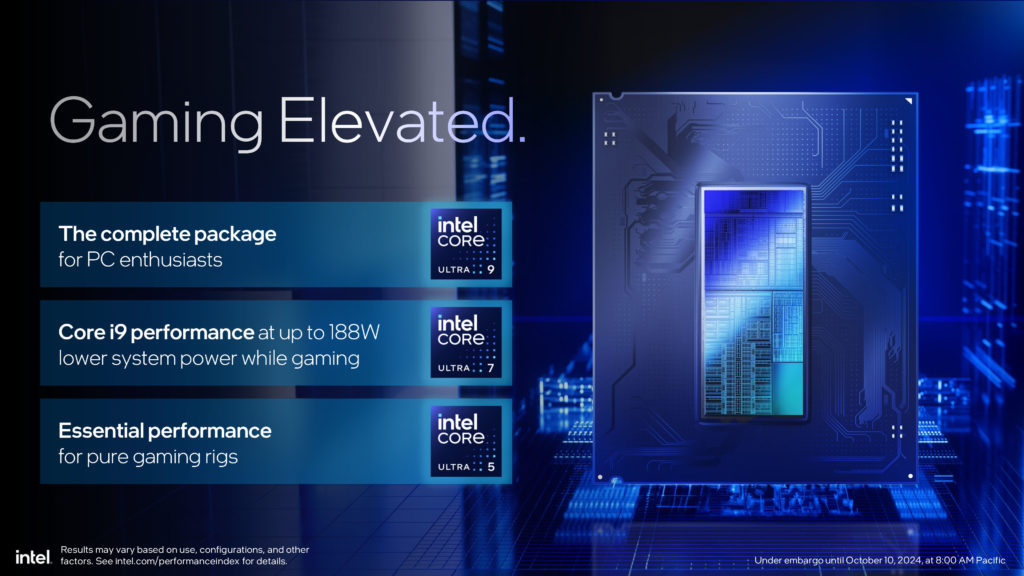
Intel is also claiming a leap forward in gaming performance per Watt. It is important to note that Intel is claiming the same framerates as Raptor Lake-R at up to a 165W system power with a geomean of 73W, but results do vary. Intel is testing system power here, not strictly CPU power, and APO is enabled in their testing. This also leads to Arrow Lake running cooler, averaging 13c cooler package temps versus Raptor Lake-R.

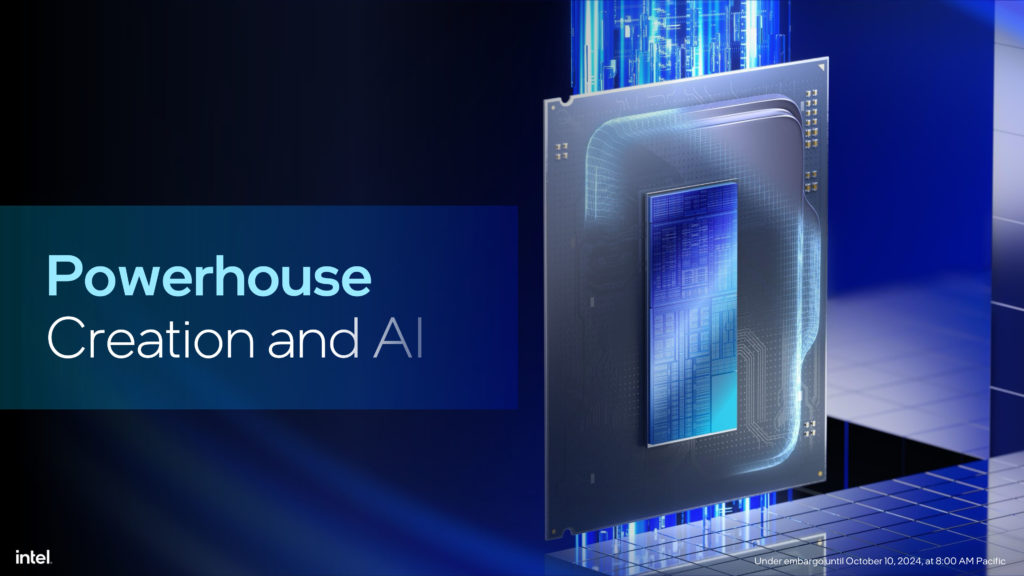
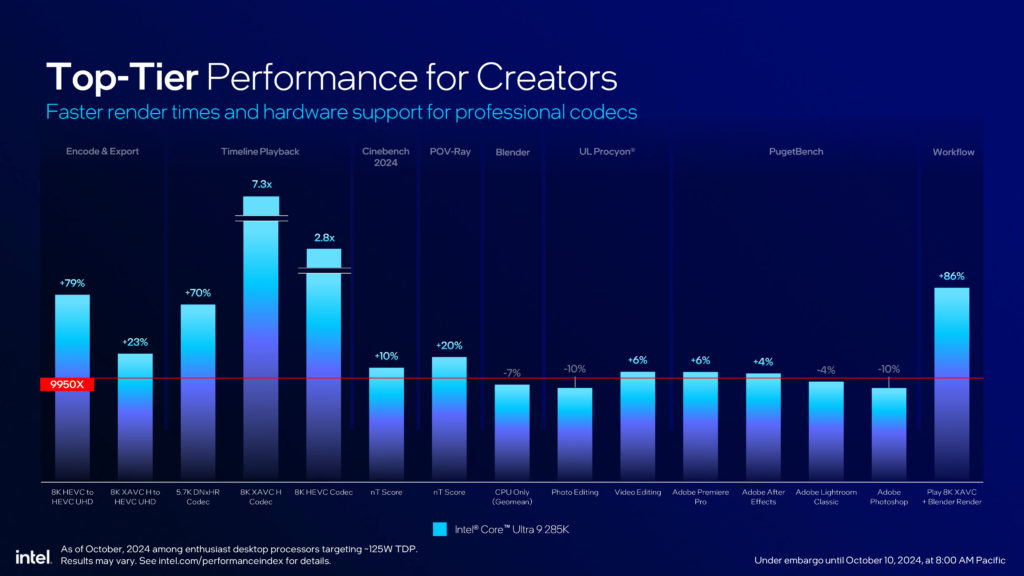
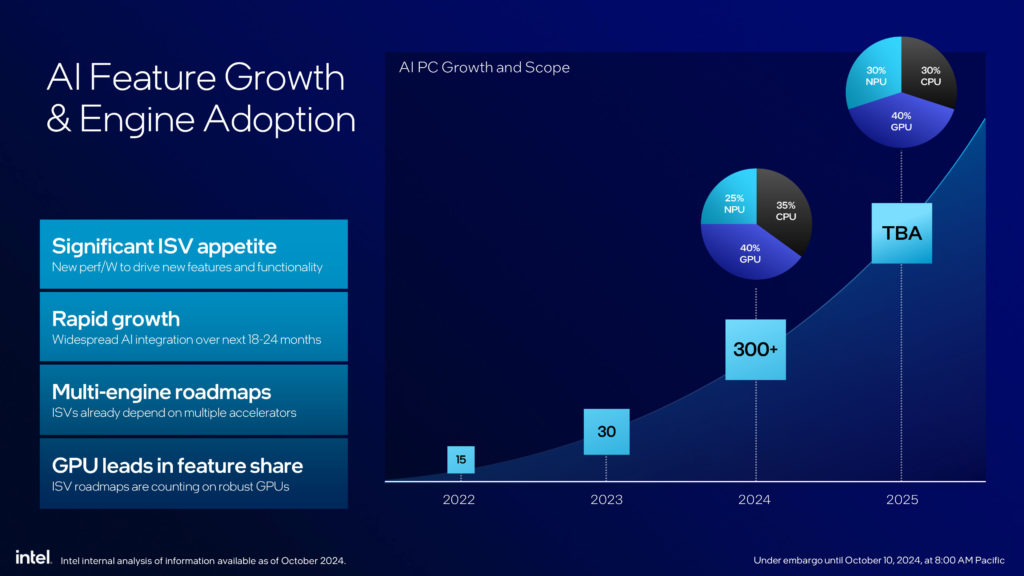
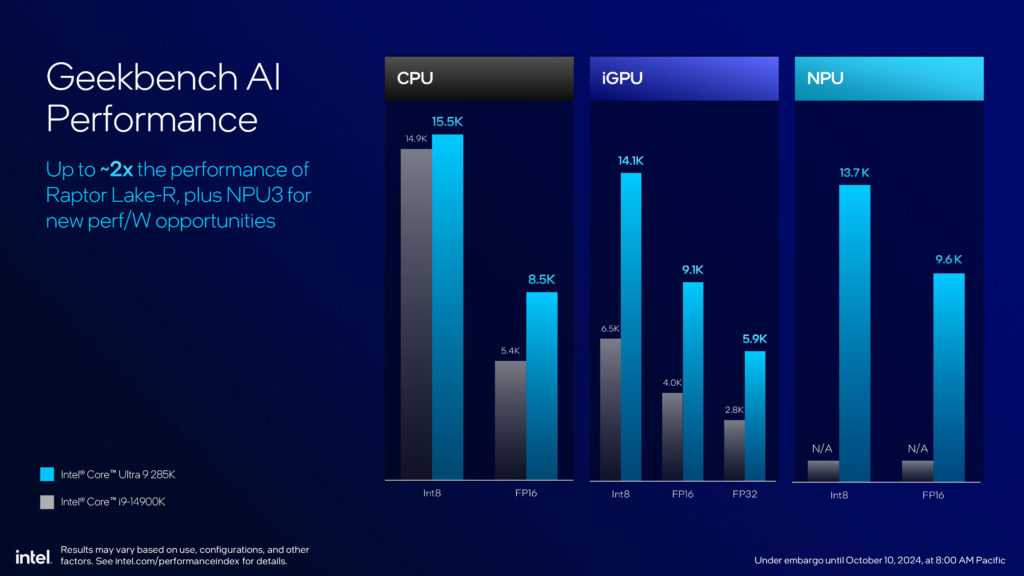
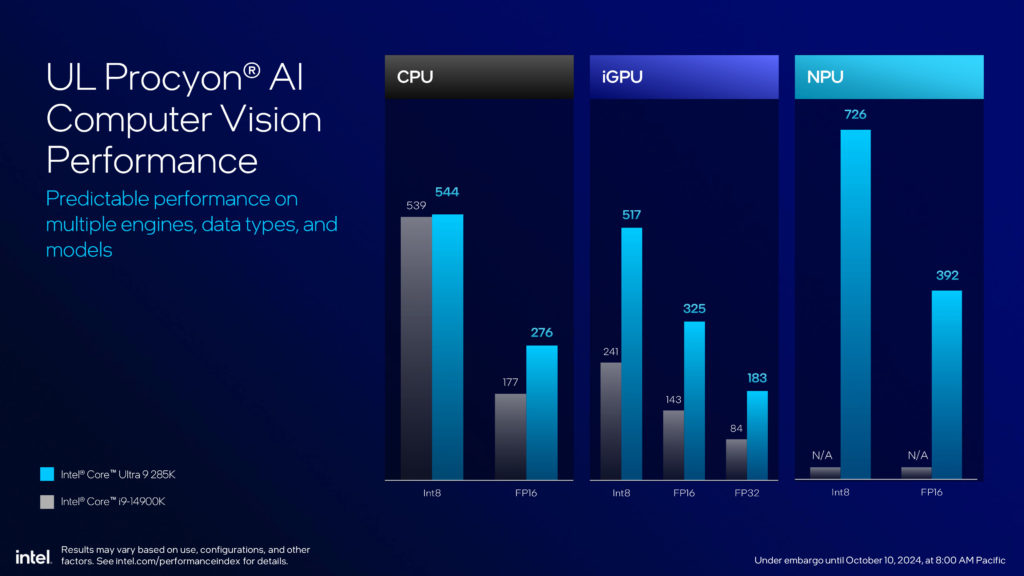
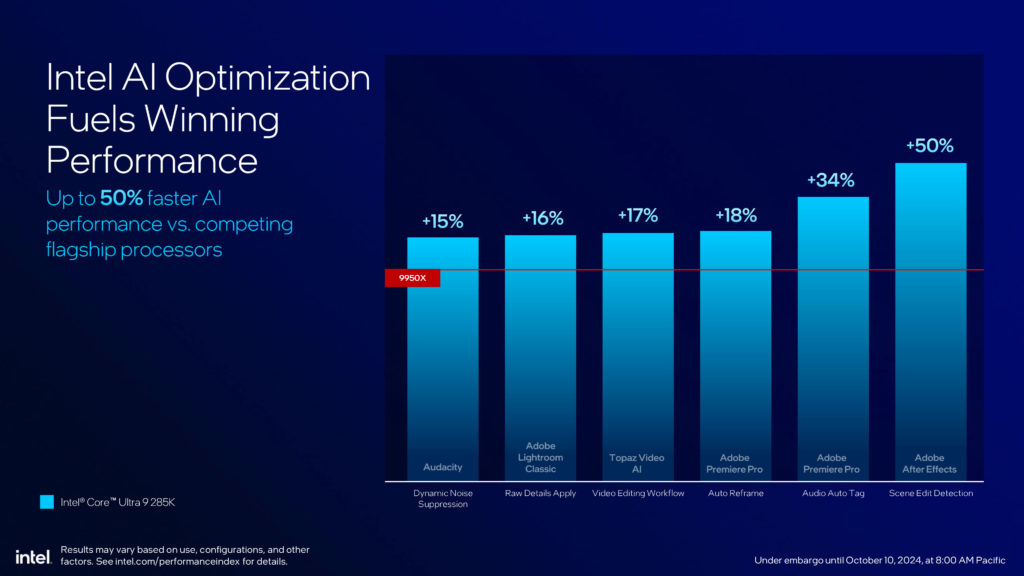
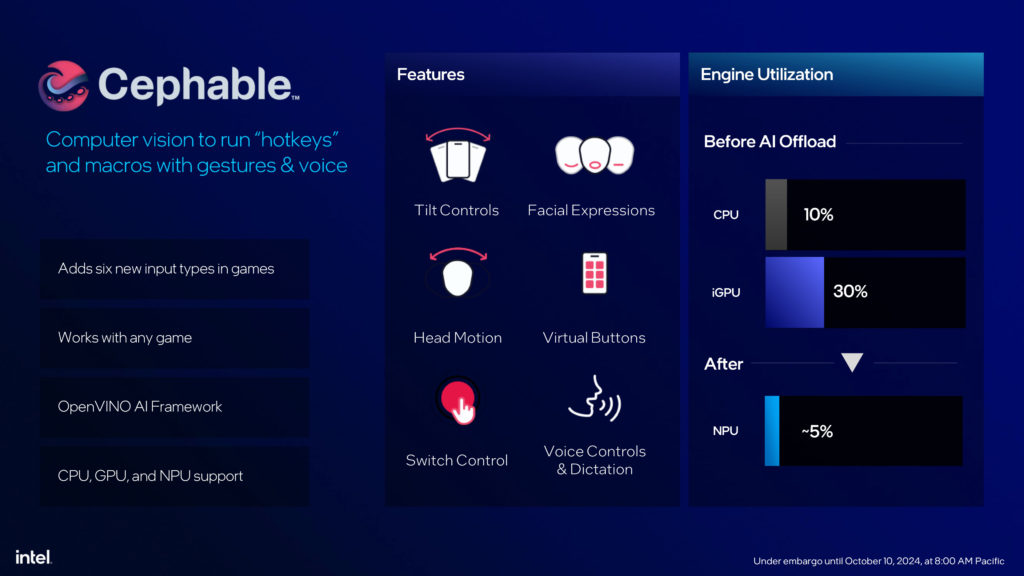
Intel is claiming top-tier performance for creators with up to 2x the performance of Raptor Lake-R and an NPU for opportunities for performance/W savings, in let’s say business PCs that do not have a dedicated GPU.
Intel 800 Series Chipset
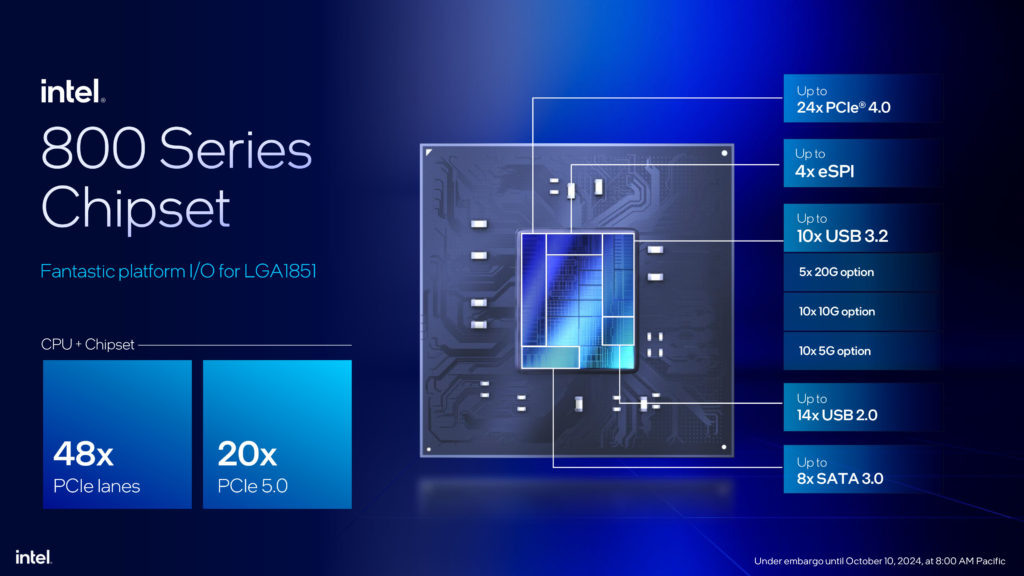
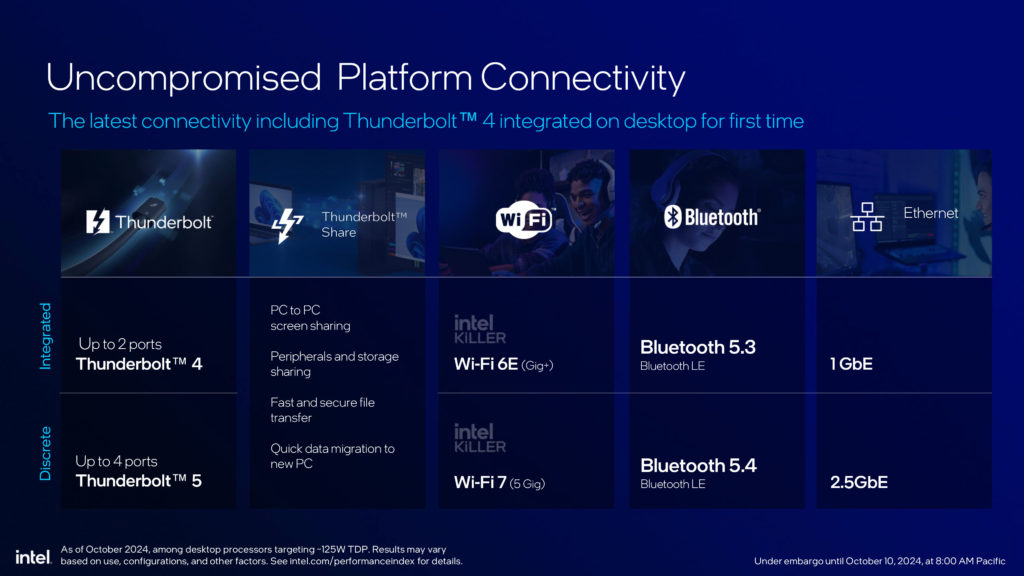
As we mentioned, with the Intel Core Ultra 200S series comes the need for a new Socket, in this case, Socket LGA1851. Intel stated that existing AIO solutions will work, new mounting hardware is not necessarily needed, however, check with your cooler vendor for AIO support and if any new mounting hardware is available, such as brackets, backplates, or special offset brackets.
We are also getting a new 800 Series Chipset, in this case Z890. With the CPU and chipset combined, we will have up to 48x PCIe lanes, with 20x of those being PCIe 5.0 lanes. The chipset itself will carry up to 24 PCIe 4.0 lanes and overall will provide up to 4x eSI, 10x USB 3.2 (5x 20G option, 10x 10G option, 10x 4G option), and up to 14x USB 2.0 as well as up to 8x SATA 3.0.
On the desktop, we will have up to 2 ports of Thunderbolt 4 and discrete options of up to 4 ports of Thunderbolt 5. Integrated there will be Intel Killer Wi-Fi 6E with discrete options of Wi-Fi 7. Integrated there will be Bluetooth 5.3, and discrete options of Bluetooth 5.4. Integrated will be support of 1GbE LAn, and 2.5GbE discrete options.
Overclocking and Memory

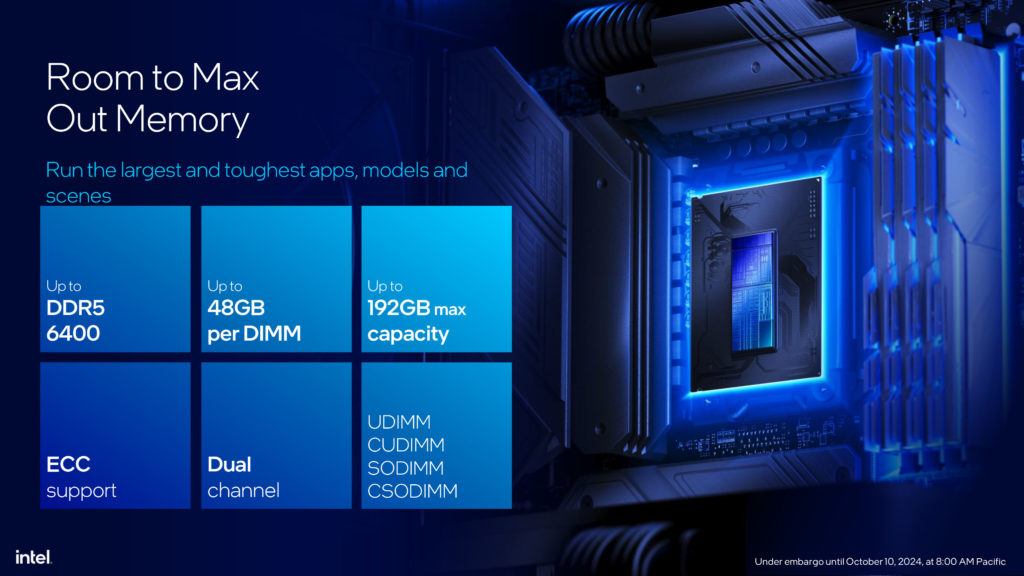
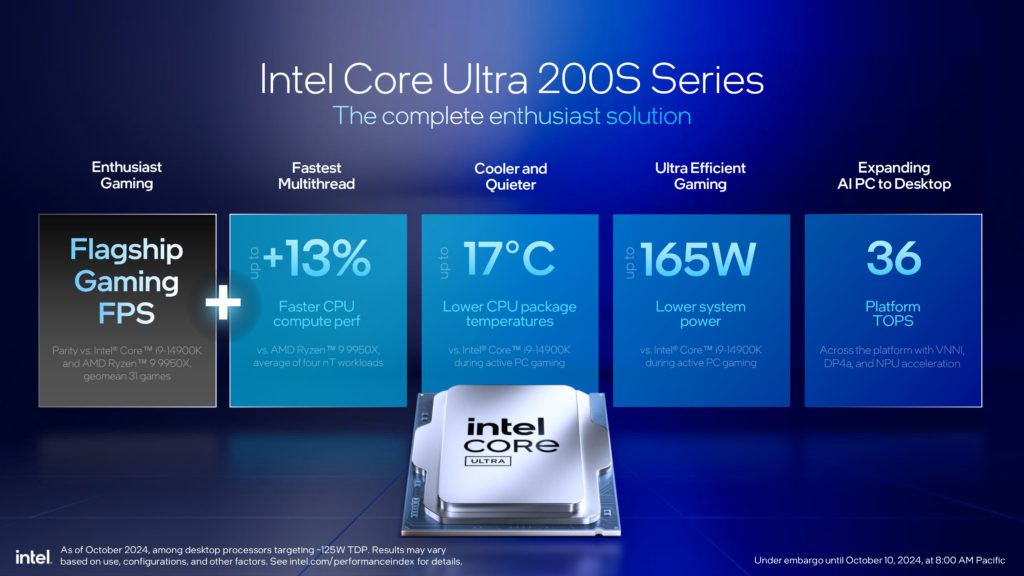
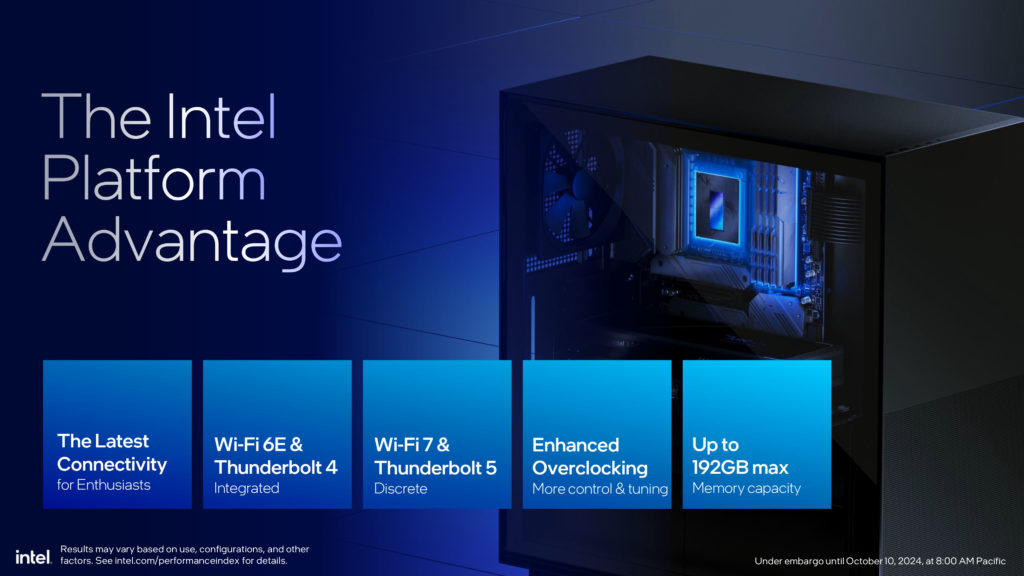
Intel Core Ultra 200S series supports new overclocking functionality with fine-grain control. You will be able to run an independent BCLK for SoC and compute tiles. It also supports the Intel eXtreme tuning software utility. Memory overclocking continues through the new memory controller with new XMP and CUDIMM DDR5. There is support for UDIMM, CUDIMM, SODIMM, and CSODIMM memory and up to 192GB max capacity and supporting up to 48GB per DIMM with ECC support. JEDEC 6400MT/s is the default spec for 1DPC and 5600MT/s for 2DPC.
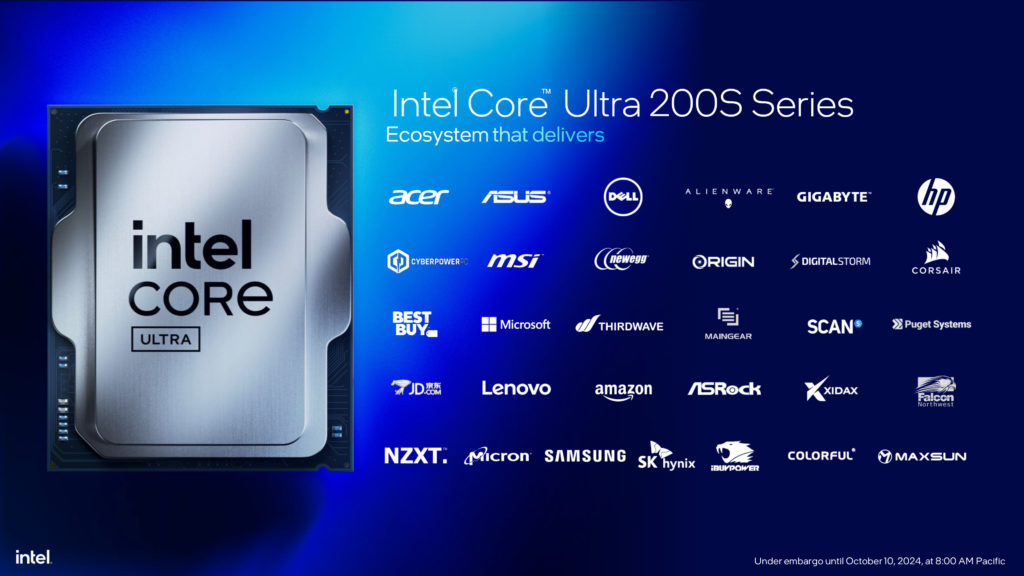
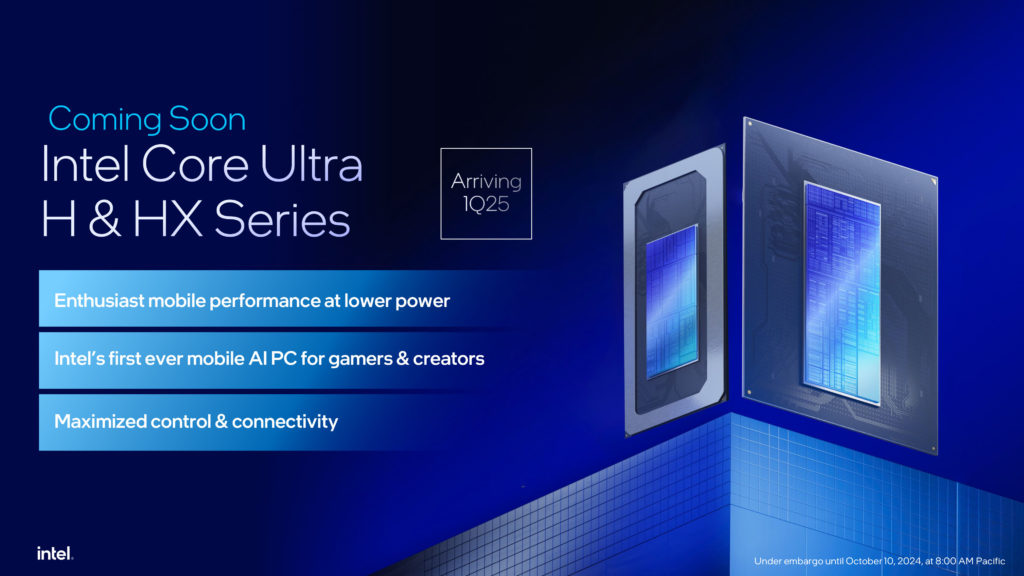
Conclusion – Thoughts & Opinions
We can’t wait to get our hands on the Intel Core Ultra 200S series and see how it all shapes up in real-world testing. What matters to most PC enthusiasts will be the advantages compared to the previous generation, Raptor Lake-R, which we reviewed on our site. We are looking for improvements in performance, and importantly power efficiency improvements. Raptor Lake and Raptor Lake-R were a lesson in what can happen when chasing performance, at the cost of power.
Looking at the specifications, moving away from Hyperthreading (SMT) from Intel is a major new paradigm shift. We saw it with Lunar Lake, but that is shaping up to have worked out in that platform’s favor. It is certainly something to get used to from Intel on the desktop side, where power savings isn’t, and doesn’t always have to be the primary driving force. However, if enough performance improvements can be made on a per-core IPC basis to where you just don’t need it, and removing it really does give you power savings, then maybe it will all make sense.
The performance expectations provided by Intel are interesting, to say the least. Intel did make it very clear, and transparent in their briefing that performance is expected to be 5% below (slower) than the equivalent AMD X3D CPU part as well. This, therefore, does set expectations, and we will see if that is correct. It is good to see Intel set an expectation with the tech press. There is a lot to unpack and test.
Some important testing factors to focus on will be the comparison versus Raptor Lake. What will the performance really end up being compared to Raptor Lake? What will the actual power differences be versus Raptor Lake? Will we actually find any advantages to upgrading to the Intel Core Ultra 200S series? We also need to consider what is important for gaming performance, that being IPC and clock frequency. BTW, we asked, and Intel stated that with the Intel Core Ultra 9 285K and Intel Core Ultra 5 265K PL1 and PL2 will be locked at 250W and the Performance Profile is the default and recommended Profile for the CPUs.
It is certainly going to be an interesting battle with the latest generation from the competition as well. We think reviews will end up with differing conclusions once again, simply based on the applications and games tested.
Final Points
Overall, Intel will be launching the Intel Core Ultra 200S series on October, 24th. We know that the pricing will be set as such: Intel Core Ultra 9 285K will be $589, the Intel Core Ultra 7 265K will be $394, the Intel Core Ultra 7 265KF will be $379, the Intel Core Ultra 5 245K will be $309, and the Intel Core Ultra 5 245KF will be $294.
Competitively, the Intel Core Ultra 9 285K is priced cheaper than AMD’s current flagship CPU (9950X at $649) but the 24-Thread 285K is priced higher than the 24-thread 9900X at $499. The Intel Core Ultra 7 265K at 20-Threads is slightly higher priced than the 16-Thread 9700X at $359. The Intel Core Ultra 5 245K at 14-Threads is also slightly higher priced than the 12-Thread 9600X at $279.
Street pricing will matter, and some of those AMD CPUs can be found below MSRP at this time, which will put a lot of pressure on the Intel Core Ultra 200S series. Ultimately, the Intel Core Ultra 200S series constitutes a higher cost, as it does require a new motherboard as well to work since this is a shift to a new socket, Socket LGA1851. That will have to be factored into this launch, and your buying decisions. At this time, Intel has not commented on future longevity of this socket, and/or support of any upcoming CPUs on this socket.
Make sure to check back on our website on October 24th, for reviews of these CPUs and Z890 motherboards, with continuing coverage and follow-ups. You can also check out all of our Intel CPU reviews in the link.
